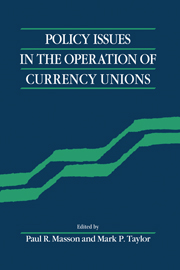Book contents
- Frontmatter
- Contents
- List of contributors
- Preface
- I Assessing the literature
- II Existing currency unions
- III Is Europe an optimum currency area?
- IV EMU: The road from Maastricht
- 8 The European System of Central Banks after Maastricht
- 9 A European money demand function
- 10 Monetary union and fiscal union: a perspective from fiscal federalism
- Index
9 - A European money demand function
from IV - EMU: The road from Maastricht
Published online by Cambridge University Press: 04 August 2010
- Frontmatter
- Contents
- List of contributors
- Preface
- I Assessing the literature
- II Existing currency unions
- III Is Europe an optimum currency area?
- IV EMU: The road from Maastricht
- 8 The European System of Central Banks after Maastricht
- 9 A European money demand function
- 10 Monetary union and fiscal union: a perspective from fiscal federalism
- Index
Summary
Introduction
As a result of the increasing degree of European integration and exchange-rate stability within the European Monetary System, spillover effects and currency substitution can be expected to affect single-country estimates of the money demand function. If not properly taken into account, such misspecification will lead to bias in the estimated parameters of the model and potential instability in the estimated function. It has recently been suggested that estimation of an area-wide (EMS) demand for money function may provide an appropriate solution to such misspecification, although the benefits thereby achieved may only be obtained at the cost of introducing aggregation bias into the relationship.
This chapter examines the issues underlying the estimation of such an area-wide money demand function in the context of two alternative monetary aggregates, M1 and M2. A two-stage cointegration methodology is applied to provide estimates of money demand over both the period preceding and following the introduction of the EMS framework. In addition, the chapter also reports upon the effect of disaggregating the relationship to the individual country level and reveals that, not only might the conditions for complete aggregation not be met within the system, but that the desirable characteristics attributed to the aggregate relationship appear to depend upon behavior within individual countries. The implications of this result for monetary policy within a complete monetary union are discussed in the final section of the chapter.
- Type
- Chapter
- Information
- Policy Issues in the Operation of Currency Unions , pp. 240 - 263Publisher: Cambridge University PressPrint publication year: 1993
- 22
- Cited by



